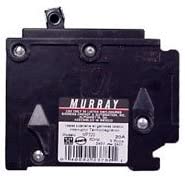Murray Circuit Breakers
Circuit breakers are a crucial component of an electrical power system. They act as automatic electrical switches to protect an electrical circuit from damage, due to excess current caused by an overload or short-circuit. Circuit Breakers exhibit this function by inhibiting current flow once a fault is present.
Need Murray Replacement Breakers?
Get Circuit Breakers Quote
Murray circuit breakers were among the first circuit breakers to appear on the market. The first type of breakers available were thermal-magnetic circuit breakers, utilizing thermal and magnetic features to control excess current during a fault.
Murray circuit breakers revolutionized electric power control and remain the most commonly used breaker.
Who Invented the Circuit Breaker?
Thomas Edison originally sketched out the concept of how a circuit breaker works. The idea is simple: A circuit breaker is a device that automatically disconnects an electric circuit when the current levels become too high. By interrupting the circuit, the breaker prevents overloads and the resultant risk of fire or explosion.
The first circuit breaker was installed in 1898 in Boston. In 1904, Cutler began manufacturing the first generally-accepted circuit breaker. Eventually, in 1922, the AIEE (American Institute of Electrical Engineers) agreed to specifications and standardization of circuit breakers.
Today, every electrical system uses a circuit breaker.
What Are the Features of a Murray Circuit Breaker?
Murray breakers are classed as single pole thermal-magnetic breakers. These breakers consist of two alternate switching mechanisms: a bimetal switch and an electromagnet.
The bimetal switch controls excess currents. When the current exceeds the set parameters, the increased heat bends the bimetal, causing it to trip a bar. This rotates the trip bar and opens another path for the current, preventing an overload.
The electromagnetic part is made up of a metallic center surrounded by a wire coil, forming an electromagnet. When excess current flows through the wires, the electromagnet generates sufficient field strength to attract a nearby armature. Movement of the armature towards the electromagnet ultimately opens an electrical pathway, stabilizing the electromagnetic coil.
Limitations of Murray Circuit Breakers
Murray breakers have the advantage of exhibiting rapid excess current control, extinguishing the arc between breaker contacts in as little as 4 msec.
Murrays have three major limitations which may result in breaker failure and the need to replace the circuit breaker:
- Extremely Vulnerable to Heat: Temperature rises due to electrical current flowing through the breaker affect the bending capabilities of the bimetal and eventually wear out the bimetal.
- Unable to Withstand High Current Loads: Murray circuit breakers can withstand only three to four times the standard full load current. This is usually sufficient in areas with stable current flows. However, in places with frequent current surges, this can cause problems.
- Susceptible to Wear and Tear: The metal strips within the Murray circuit breakers become weaker as the strips are exposed to an electrical current. This affects the breakers ability to trip and exposes the circuit to overload.
What Breakers Are a Plausible Replacement for Murray Circuit Breakers?
There are several types of circuit breakers on the market that can replace a Murray.
Air Circuit Breakers: This type of breakers acts differently from their Murray counterparts; they control excess current by acting as arc-extinguishing mediums that operate at specific atmospheric pressures. Contractors often use air circuit breakers for low voltage applications (<450V).
Air circuit breakers have a reputation for being very durable, plus they perform well and are easy to install and maintain. Additionally, there is no fire risk with an air circuit breaker.
Square D Circuit Breakers: Square D breakers work on the same principles as their Murray equivalents.
The advantages of Square D breakers include a very robust design and easy installation. Square D circuit breakers function reliably and are very safe. Square Ds feature a window with a visual trip indication flag, enabling easier identification of a tripped breaker.
Cutler-Hammer Circuit Breakers: Cutler Hammer breakers have excellent current control capabilities. Other features praised by users include a robust design, easy installation, reliable performance and long-life.
Conclusion
Circuit breakers are an essential part of every building or facility’s electrical system. Furthermore, circuit breakers protect the electrical circuit from damage due to excess current.
While Murrays are an excellent choice, there are several other varieties sold that function slightly differently than a Murray and make suitable replacements.
